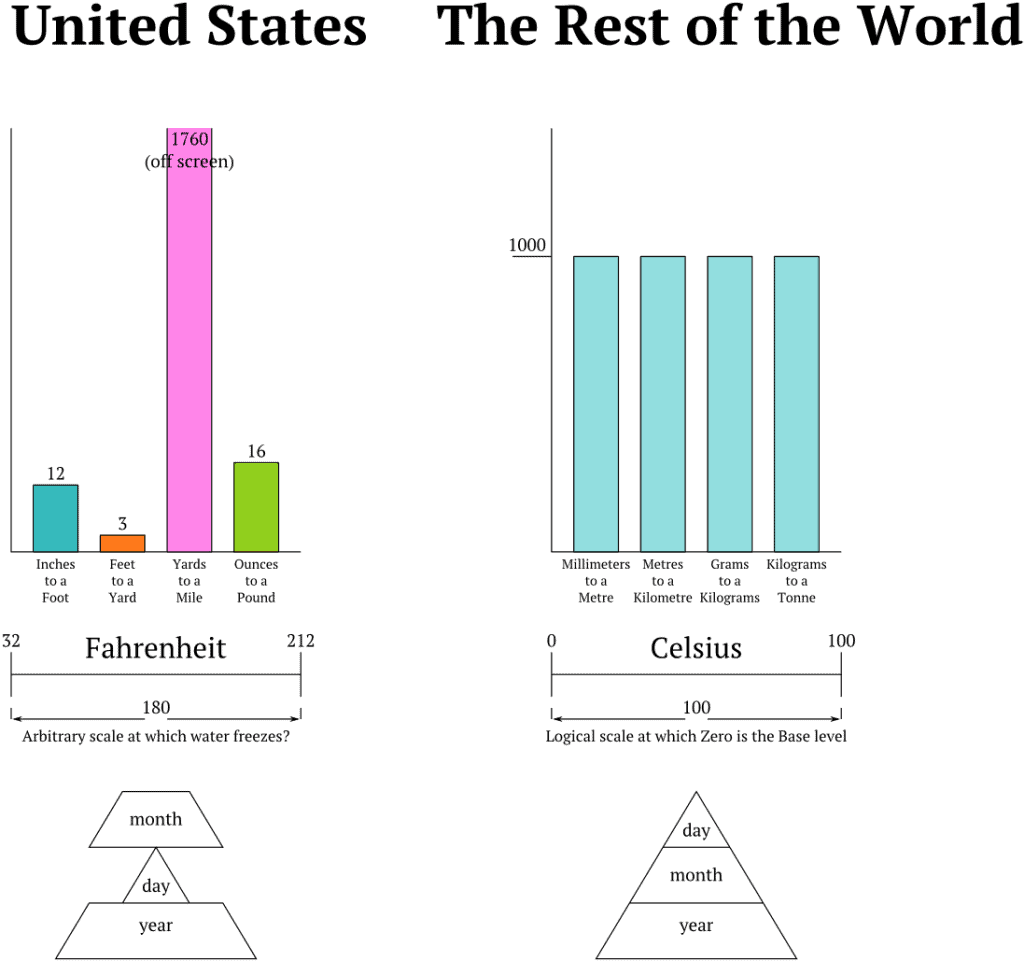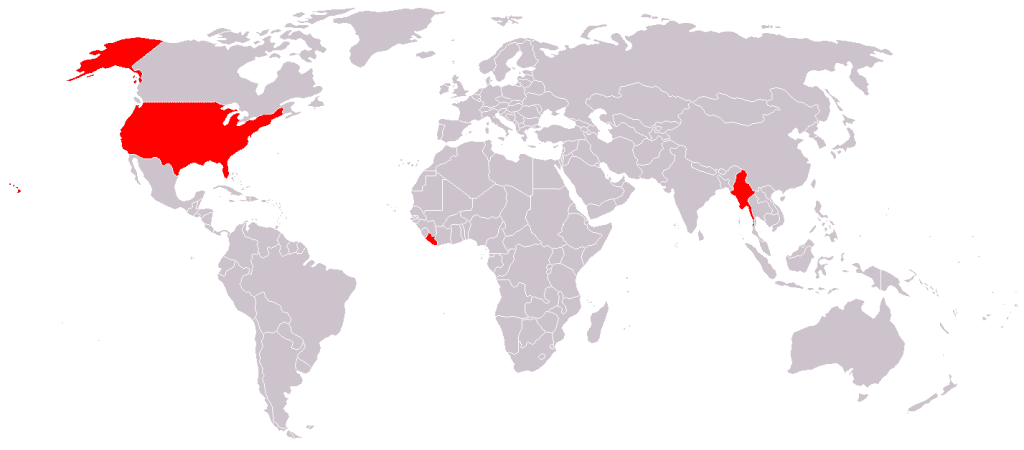There are over 195 countries in the world, but only three of them insist on still using the outdated imperial system. This map is particularly striking.
The three countries which are not using the metric system are Liberia, Myanmar, and of course… the United States of America. But why is the United States so keen on using miles and gallons when the rest of the world has long moved on and embraced the metric kilometer and liter?
Why the US uses the imperial system

When the British Empire colonized North America hundreds of years ago, it brought with it the British Imperial System, which was itself a tangled mess of sub-standardized medieval weights and measurements. By the time America proclaimed its independence in 1776, the former colonies still had trouble measuring physical quantities uniformly across the continent.
In fact, the forefathers knew this well and sought to address the problem. The first step was granting Congress the power “to coin Money … and fix the Standard of Weights and Measures,” as stated in Article I, Section 8 of the newly formed Constitution. In 1790, secretary of state Thomas Jefferson made an analysis of the matter and felt reluctant to stir his country towards the decimal-based metric system — at the time still a fledgling standard born in France.
America’s icy relationship with France didn’t help too much, either. The proclamation of the metric system was made on June 22nd, 1799 in Paris and was subsequently housed at the Archives of the Republic as the physical embodiment of the standard. The prototype meter and the prototype kilogram, both made of a platinum alloy, were witnessed by representatives of the French and several foreign governments, as well as some of the important natural philosophers of the time. However, France snubbed the U.S. when it invited dignitaries from foreign countries to travel to Paris to learn about the metric system.
It’s important to note, however, that even if US representatives had traveled to Paris, they most likely wouldn’t have returned with favorable news. In 1821, after studying the various units of measurement used by the 22 states, Secretary of State John Quincy Adams determined that the U.S. Customary System was sufficiently uniform and required no changes. Most people actually believed that the metric system wouldn’t survive Napoleon’s rule. They were wrong, however, and by the time the American Civil War ended, most of Europe had turned metric — except for the proud British of course.
In 1866, an act of Congress signed into law by President Andrew Johnson made it “lawful throughout the United States of America to employ the weights and measures of the metric system in all contracts, dealings or court proceedings.” The act, however, was merely an act of recognition, which didn’t necessarily translate into practical use.
Following WWII, the world started a cycle that’s still continuing today: globalization. As America was importing and exporting more and more goods, it found itself in a predicament when trading with other countries, as most of them were using the metric system.
American companies had to make twin labels, train workers and students on both systems and re-purpose thousands of machines across various industries. The costs were, and still are, enormous. With this in mind, some Congressmen proposed the US finally switch to metric. In 1971, the U.S. National Bureau of Standards issued a report titled “A Metric America”, recommending that the U.S. transition to the metric system over the course of ten years. In response, Congress enacted the Metric Conversion Act in 1975 to commence the conversion process. However, the implementation was extremely lacking — someone had the bright idea to strip out the 10-year deadline and make the conversion voluntary — and, of course, no one wanted to willingly change to metric. However, the Metric Board was dissolved in 1982, and the metric system failed to gain wide acceptance in the United States.
Why the US still doesn’t use the metric system

So, the U.S. really tried to switch, but it failed miserably. But why?
Switching to the International System of Units, or metric, is, in a sense, like switching to another language. It’s just tough and mentally taxing until you get used to it. If you’re not American, picture this: how would you feel if your government enacted a new rule that forced you to switch to the imperial system? Yes, the metric is simpler and uses fewer units, but rational reasons aside, you’d be furious simply because you’d have to change the frame of reference you’ve been using all your life.
The UK switched to metric in 1965, and this happened only because the industry forced it. UK companies were simply having too much of a hard time trading with European countries. Even 50 years later, many Britons still refuse to move entirely to metric. Distances are still measured in miles, yards and inches, weight in pounds and stones; liquids in pints and gallons.
However, the US isn’t pressured by the same trading problems as the UK. You don’t need the metric system to measure one car made in Japan, or one iPad from China, or to license an SQL Server to Germany. Most of the food and drinks are made and used within the US. As far as science and industry go, nowadays most work in SI units. So, at least for now, Americans are still fine without the metric system though sometimes problems and confusions surrounding the conversion can cause disasters. For instance, one conversion error between US and metric measurements sent a $125 million NASA probe to its fiery death.
“The use of two different unit systems was the cause of the loss of the Mars Climate Orbiter in 1998. NASA specified metric units in the contract. NASA and other organizations applied metric units in their work, but one subcontractor, Lockheed Martin, provided thruster performance data to the team in pound force seconds ainstead of newton seconds. The spacecraft was intended to orbit Mars at about 150 kilometers (93 mi) altitude, but incorrect data probably caused it to descend instead to about 57 kilometers (35 mi), burning up in the Martian atmosphere.” – Wikipedia
In the U.S. Customary System, a.k.a. the inch-pound system, there are more than 300 different units that exist to measure various physical quantities. Many of those units use the same name but have very different meanings. On the U.S. Metric Association Web site, contributor Dennis Brownridge identifies at least nine different meanings for the unit we know as a “ton”: short ton, displacement ton, refrigeration ton, nuclear ton, freight ton, register ton, metric ton, assay ton and ton of coal equivalent. This is downright confusing even for Americans!
But while there is a cost to using the U.S. Customary Units in an overwhelmingly metric world, there are also important costs associated with a transition. he conversion to the metric system would require a significant investment in new measuring instruments, new signs and labels, and new equipment for businesses and industries. This cost would be passed on to consumers, and many Americans are not willing to bear the additional expense.
However, there are signs that the U.S. may be ready to make the switch to the metric system. In recent years, there have been renewed efforts to convert to the metric system, and there is growing support for a national mandate to convert to the metric system. The National Institute of Standards and Technology (NIST) has been working to promote the use of the metric system in the United States, and the organization’s efforts have been met with a positive response.
It seems that the conversion of the US to the metric system is more of a “when” than an “if”. After all, Myanmar (formerly Burma) recently announced it plans to switch to the metric system soon, leaving the US in the fine company of Liberia as the only two countries in the world who haven’t switched to metric.



